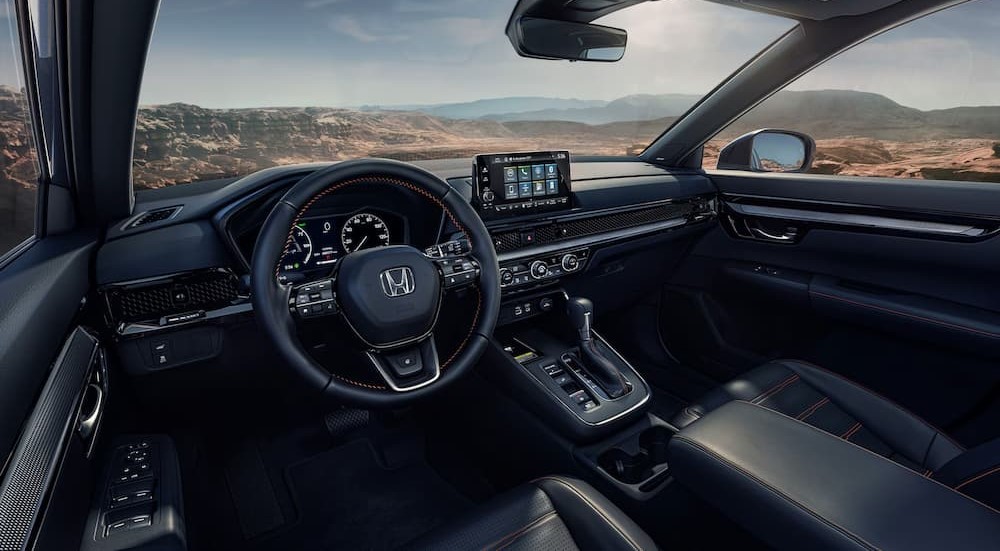Hybrids have been around for years, but they have recently been receiving a lot more attention than before due to emissions standards becoming increasingly strict and many top auto manufacturers moving toward greener powertrain designs. Part of this new push to refine and improve the hybrid ecosystem is a bevy of new hybrid SUVs across the board, including some of the latest outings from popular makers such as Honda and Toyota. In the past, Honda wasn’t quite as aggressive in pursuing hybrid technologies as Toyota, although the Honda Insight was the first hybrid available in America, but recently, that has changed.
These days, both companies have been diligent in offering hybrids for multiple segments, including providing hybrid variants of their highly popular compact SUVs. So how do the 2024 Honda CR-V Hybrid and the 2024 RAV4 Hybrid match up when it comes to their hybrid designs? Both offer unique engineering architecture that changes how you view and potentially seek to drive a hybrid compact SUV, and it all starts with the removal of key powertrain components. Yes, the removal of key powertrain components. But first, we have to understand what the powertrains of both these hybrid compact SUVs have to offer.
Starting With the Basics
The basic powertrain specs for the 2024 Honda CR-V Hybrid are that it is powered by an internal combustion engine of the 2.0L variety configured as an inline four-cylinder. It is paired with a lithium-ion battery pack and two direct-drive electric motors that help with battery regeneration and propulsion. In total, the CR-V Hybrid makes a combined 204 hp and 247 lb-ft of torque. You can get the 2024 CR-V in two different drivetrain configurations, either as a front-wheel drive or an all-wheel drive SUV.
The 2024 RAV4 Hybrid is powered by a 2.5L inline four-cylinder. Like the CR-V Hybrid, the RAV4 Hybrid is also powered by two electric motors that operate in similar ways to the CR-V, with a larger motor working as the propulsion motor and a smaller motor supplying power to a nickel-metal hydride battery pack. The RAV4 Hybrid manages to produce a combined 219 hp and is only available in all-wheel drive. You might think these vehicles are similar on the surface, but that couldn’t be further from the truth.

How the 2024 Toyota RAV4 Achieves Its Hybrid Design
The RAV4 Hybrid is unique in the sense that its propulsion is achieved through mechanical gears powered by a battery pack and the 2.5L four-cylinder engine. Electrification is achieved due to two electrical motors, known as MG2 and MG1, the former of which makes 118 hp and 149 lb-ft of torque, whereas the latter is much smaller. You might also be thinking, “Why not order them as MG1 and MG2?” and that’s a relevant question. The reason is their designated roles. MG2 is actually the main electric motor that provides propulsion to the vehicle, while MG1 is a secondary motor that provides power for the battery and serves as the starter.
The RAV4 Hybrid doesn’t use a traditional transmission. Instead, it has a planetary gearset known as an “eCVT” to provide you with different levels of propulsion. The trick is that the MG1 generator doesn’t do any of the actual propulsion work…all of that rests on the shoulders of MG2, the larger electrical motor that provides all of the torque. Both MG1 and MG2 are connected to a mechanical gearset that connects them to the 2.5L engine. But you might be asking, “If there is no alternator or starter, how does the vehicle turn on?” And the answer to that is…MG1.
Propulsion is achieved primarily with the gasoline engine, supplemented by the MG2 electrical motor. This provides the RAV4 Hybrid with very quick off-the-line torque. The planetary gear housing works as a continuously variable transmission, so as you depress the accelerator, it utilizes the planetary gears to keep the gasoline engine at its optimum powerband. Thanks to the dynamic drive ratios, the RAV4 is great at conserving fuel even with an all-wheel drive design.
How the 2024 Honda CR-V Achieves Its Hybrid Design
Much like the RAV4 Hybrid, the CR-V Hybrid also utilizes multiple electric motors and an Atkinson-cycle internal combustion engine to power the battery pack that keeps the electric motors powered. The CR-V Hybrid’s larger electric motor is the one that does most of the heavy lifting, producing 181 hp and 247 lb-ft of torque on its own. It also feeds off the power supplied to it from the 2.0L four-cylinder engine. The secondary motor is a generator that supplies power to the lithium-ion battery pack, which is very similar to how the generator works for the RAV4 Hybrid. The two motors and the internal combustion engine work in concert to provide propulsion to the vehicle, with the main electrical motor doing most of the work.
Where the CR-V Hybrid differs from the RAV4 Hybrid is that it doesn’t have a planetary gearset or any other form of transmission. Instead, the engine and electric motors are directly connected to the front axle. A system of low-speed and high-speed clutches allows the gasoline engine to stay in the right RPM range at different speeds or disconnect entirely and let the electric motors take over.
Design Impact on Fuel Economy
With how complex these systems are and how uniquely they’re designed, one has to wonder how all of this high-level mechanical and electrical engineering impacts the fuel economy for both compact SUVs? Well, both have enviable top marks according to the EPA, with the 2024 RAV4 Hybrid topping out at 41 MPG in the city and 38 MPG on the highway. The 2024 CR-V Hybrid manages similar figures in all-wheel drive at 40 MPG in the city and up to 34 MPG on the highway.
What clearly separates the two is the CR-V Hybrid’s front-wheel drive configuration, which tops out at 43 MPG in the city and 36 MPG on the highway. Those are impressive figures for the CR-V Hybrid, especially given that it’s larger than the RAV4 Hybrid, which is seen in its larger interior cabin and more expansive cargo volume. However, it manages better fuel economy in the city than the RAV4 Hybrid, thanks to Honda’s hybrid system relying primarily on the electric motors rather than the gasoline engine.
Which One Is Better?
A final verdict on drivability will boil down to tastes. The RAV4 Hybrid, with its larger engine and planetary gearset, will drive a bit more like a traditional gasoline vehicle, while the electric-motor-first philosophy of the CR-V Hybrid feels more like an electric car. Reliability will depend mostly on how well you keep both vehicles maintained and serviced, as both brands have excellent reputations for dependability and have been building hybrids for two decades now. Deciding which is “better” will ultimately come down to driver preference, as both vehicles do something the other doesn’t, but in ways that will appeal to specific kinds of SUV drivers. But what do you think? Which 2024 hybrid compact SUV do you feel has the better design and is a better take on hybrid engineering?





